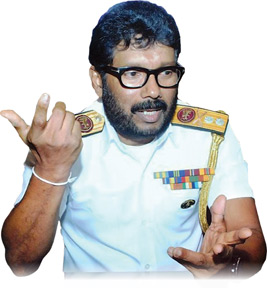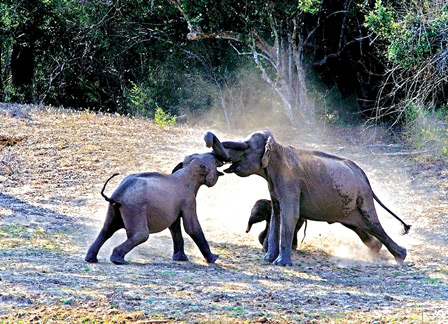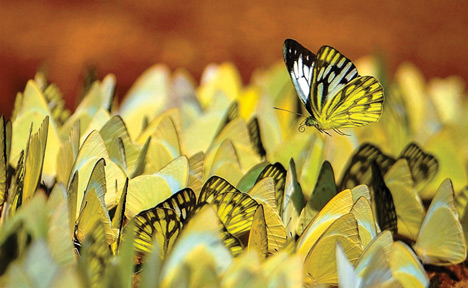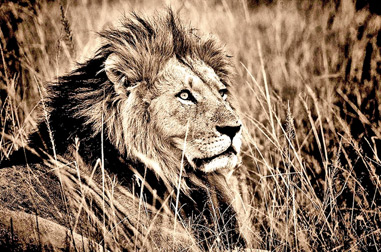|
Dr. Lalith Ekanayake:
The quintessential Wildlife photographer
By Sureshini Pilapitiya
What is nature without silvery waterfalls, the natural habitat, green
hills and landscapes? Can you imagine life without them? Nature itself
is God’s gift to mankind and unfortunately, man himself seems to destroy
it.
While most of us miss the beauty of nature, Rear Admiral and surgeon
Dr. Lalith Ekanayake, is a wildlife enthusiast, photographer and also a
writer who has written two coffee table books “The Untamed Road and
Animal Verses”.
|

Pix: Siripala Halwala |
He has won many international awards and medals for his photography.
He won the ISF (Image Sans Frontire) Gold Medal at the recently
concluded third Taiwan International Salon of Photography 2014 and WAHP
(World Association of Hungarian Photographers)Silver Medal at the 1st
International Salon of Art Photo Carpatian Drag 2014 In Serbia.
Also two of his photographs have been highly commended at the
“Digital Photo Archives 2014” competition in Ireland.
He has won the first prize and the title of Sanctuary Asia Wildlife
Photographer of the year 2013 at the 2013 Sanctuary Asia Wildlife
Photography competition in India, First place and the UPI Gold Medal,
Third Place and PSSL Bronze Medal and Special Mention at the 57th
International Photography Competition of the Photographic Society of Sri
Lanka 2012, First Place Wild Life Category, Third Places in Mammals and
Birds Category at the Chaaya – Wild Etisalat Photography Competition
2012.
He won the runner-up at the Wexas International Photography
Competition in UK 2012, Bronze Medal at the Trierenberg Super Circuit
International Photography Competition in Austria 2013, Silver Medal at
EMPA International Photography Competition in India, Diploma in Le
Catalan Photography Competition in France and special mentions at the
Oasis International Photography Competition in Italy 2012.
Dr. Ekanayake’s work has been exhibited in 25 countries and his
pictures were selected twice as the Editor’s Choice, Photo of the month
and photo of the day at the National Geographic International
Photography Competition 2011 and 2012.
He was also the finalist for the past few years at the BBC
International Photography Competition in the UK. He was the first Sri
Lankan to have received so many achievements. He also held two solo
Wildlife Photographic exhibitions in 2010 and 2013 in Colombo.
He dedicates all his achievements to protect the fauna and flora of
Sri Lanka which are under severe threat.
 In an interview with Montage Dr. Ekanayake expressed his views on
Wildlife Photography. In an interview with Montage Dr. Ekanayake expressed his views on
Wildlife Photography.
Excerpts:
Q: What made you take to Wildlife Photography?
A: It was not only about wildlife that I was interested. I was
basically a person involved in cultural activities as well. I was
engaged in a lot of non-scientific activities.
At the Medical Faculty I took part in dramas and was a member of the
Medical Faculty Cricket Team. I started my Photography at University.
First I took photographs of my batch mates and events. When I was a
third year student at the Medical faculty I joined the Navy. I was in
Australia for some time for Naval training.
I had some time to do a bit of exploring and travel around and take
photographs of landscapes and habitat there. On my return to Sri Lanka,
I concentrated more on wildlife photography. I started it from Yala.
(Nature lover).
Nature lover
Q: Were you interested in Wildlife photography from your
younger days?
A: I was a nature lover from my childhood. I’m from Kurunegala
and I studied at Maliyadeva College. Wildlife photography is rather a
challenging subject. I like to take challenges, being the first medical
student to be selected to join all three Security Forces at the peak of
the war against terrorism.
 All the doctors were reluctant to join the forces at that time,
because it was a risk. As a doctor you can easily join a hospital and
work. But I took that risk and joined the Navy. All the doctors were reluctant to join the forces at that time,
because it was a risk. As a doctor you can easily join a hospital and
work. But I took that risk and joined the Navy.
Q: Why did you want to take such a risk ?
A: I was involved in a lot of extracurricular activities
including sports. When I saw this advertisement in the papers calling
for recruits, I decided to apply. My parents didn’t like the idea at
all, and my friends said it was a huge risk.
I joined the Navy but they released me to complete my medical
studies. I did my internship in Kurunegala, which was memorable because
my mother was the head nurse there at that time.
Later I was posted to Trincomalee and I also worked for the Indian
Peace Keeping Force.(IPKF). When you are with your other military
colleagues you don’t feel any fear.
When I came home for my holidays my parents looked for a partner. But
when they heard that I was from the Security Forces, their response was
negative. Eventually I got married to Rasanjali and we stayed in
Trincomalee for some time. We have two daughters who are both doctors
now.
Q: How did you face terrorism at that time?
A: We had the courage to fight against terrorists. But there
was no leadership. When President Mahinda Rajapaksa took office we had
the feeling that we could defeat terrorism.
Q : How do you feel about your latest achievement in wildlife
photography winning the ISF Gold Medal at the Taiwan International Salon
of Photography?
A: It is a personal victory to me, but it is also a victory
for our country. All the victories and achievements I dedicate to our
fauna and flora, which are in danger.
Q: Are there any basic techniques and special effects you use
in wildlife photography ?
 A: No. Basically it is not the camera or the techniques you
need to have, but I feel you need to have reasonably good equipment .
But it is the person behind the camera who matters. That comes with your
experience. You can pre-visualise. A: No. Basically it is not the camera or the techniques you
need to have, but I feel you need to have reasonably good equipment .
But it is the person behind the camera who matters. That comes with your
experience. You can pre-visualise.
If I travel with five photographers at the same time, take the same
scene, all of us may have different shots. I would have a different one
and it may be even better than the others. Technology is important but
it is not the D factor here. Wildlife photography is not just going on
holiday trips.
You need experience and it is very difficult. Sometimes I spend the
whole day in a dusty place such as Yala. It is a very committed kind of
job. Your attitude , experience and commitment are important.
Q: Is there any difference between international and local
wildlife photography?
A: I don’t think so. There are International photographers who
are professionals. In BBC their profession is to take wildlife
photographs.
Their camera technology is enormous. International photographers are
well equipped and they take unusual photographs.
I don’t use any special effects, but I do use the slow shutter
technology. In a competition it is not important. I use every available
facility in the camera. I also use slow shutter or panning to photograph
a moving bird or an animal.
When you shoot a group of horses running, the picture is blurred.
When it is done by panning, a clear picture emerges. A waterfall or a
river running is done by using the slow shutter.
If you can photograph something which you cannot see with your naked
eye, that’s what makes it different. In photography we use the wide
angle as well. It is not basically zooming a picture. We have to plan it
for days, till the creature gets used to the camera.
I don’t believe in luck in photography. Of course you need that, but
more than that you need to be creative. I take uncommon photographs from
common scenes.
When I was taking one of my Wildlife photographs I saw a small
movement of water in a river. I waited for a while and I saw two
crocodiles fighting. One was a big fellow while the other one was small.
The big crocodile tried to keep a carcass of a dead deer underwater and
the small crocodile tried to grab it. The other crocodile was trying to
prevent that.
Technology
I travel a lot to other parts of the world including Botswana and
Africa. In every country I have travelled I took interesting pictures.
Wildlife photography judges are not interested in the technology, but
the way you have taken the photograph. When you take wildlife
photographs you have to wear suitable clothes.
You need a lot of physical stamina. You need to wait for long hours.
It is a strenuous job.
You have to carry big equipment and the weight of which should match
your height.
If you want to be a wildlife photographer, you need to be a strong
person.
 Q : Is there any organisation or society to protect wildlife
in Sri Lanka ? Q : Is there any organisation or society to protect wildlife
in Sri Lanka ?
A: There are many societies and organisations in Sri Lanka to
protect wildlife. But we need to get together and protect wildlife. We
need to focus more on it and at present all the organisations are doing
a great service.
Q : We hear of wild animals being killed by vehicles, and
being disturbed by tourists who come to wildlife parks. Have you taken
any action to prevent such disasters?
A: After the end of terrorism, the number of tourist arrivals
increased. Most of our wildlife parks are crowded with at least 400
vehicles a day. There should be restrictions and we have made several
plans. Because of the big crowd the discipline is also decreasing.
Human-elephant conflict
Q : What do you think of the human – elephant conflict in Sri
Lanka?
A: I think we are all responsible for that. This is not a
problem which has happened overnight , but it has been going on for
years. They have closed the elephant and animal corridors. and elephants
are roaming around the villages because they don’t have a place to live.
For paddy cultivation they need water.
In reservoirs there is water and good clean grass and animals love
this. When you have that kind of a situation you can’t help the animals
coming.
We have planned a fence which gives the animal an uncomfortable
feeling but no danger. Unfortunately fences with high voltage can kill
elephants.
Q : What do you think of the hunting of the rare species? In
some countries hunting is even done as a sport.
A: Yala itself was a hunting ground in the colonial era. But
later they turned it into a national park.
Hunting is prohibited in Sri Lanka. But it is illegally done. But in
Africa there are some private parks were they allow hunting.
Q : What about the killing of African elephants ?
A: The killing of African elephants is a big problem because
they hunt them for their tusks.
Their ivory is very valuable. It is a situation which is very
difficult to control.
These are big parks, so there is only a limited number of staff to
take care of everything.
The animals are hunted for various reasons. Rhino horns are believed
to be used to make medicine and tiger skins are used for beautification.
Dolphins
Q : And the killing of dolphins? There was a protest from New
Zealand against it.
A: The dolphins are the friendliest creatures next to dogs. It
is a pity these animals are also being hunted.
Q : What is so special in the ‘‘Ivory’’ or ‘’ Gajamuthu ‘’
inside an elephant’s tusks ?
A: Ivory are the form of calcium which is deposited in an
elephant’s tusk.
They form something similar to pebbles. There is no special value in
them.
Q : Were you inspired by anyone or anything to take wildlife
photography ?
A: I never learnt it from anyone. I did not have the time to
study photography. I studied the technology and learnt from my mistakes.
Animals and nature are my teachers. Every day you need to study
photography and then you’ll improve.
b : What is the support that you get from your family ?
A: My wife, Rasanjali and my two daughters are supporting me
immensely. The Navy officers, and Defence Secretary Gotabaya Rajapaksa
have given me tremendous support .
Q : What are your future plans?
A: I do not earn from my achievements. I do not consider it as
a hobby. I consider it as a duty in wildlife context.
If you plan your time for everything, you need to plan your
priorities.
It is a strenuous job. I travel a lot, get up early in the morning,
and my priority is given to the Navy.
I have been in the Navy for 30 years and I will do my best to protect
the fauna and flora of Sri Lanka. |

